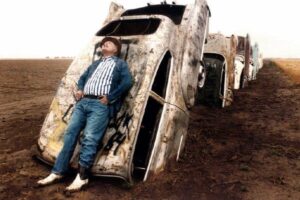A fellow and I spoke this afternoon about someone I no longer think much about, but someone who occupied a most unique position in the community where I once lived.
The individual with whom I spoke said he is putting the finishing touches on a documentary film he is producing about none other than the late Stanley Marsh 3.
He and I hope to meet face to face at a later date. We will discuss Marsh in greater detail. The gentleman, who said he lives in Austin, is looking for a more longer-range view of Marsh. He thinks I can provide it.
How is that? Well, as I told the filmmaker, I did not know Marsh well. I mostly knew of him. Indeed, this individual’s reputation was, to put it kindly, far-reaching in the extreme.
Marsh was a premier eccentric. He also possessed tons of money. He was the purveyor of avant garde artwork, such as the lawn signs that cropped up on people’s yards all over Amarillo. They had flaky, sometimes nonsensical phrases. But they were fun to read and they often drew a laugh. The signs were the product of the Ant Farm, a Stanley Marsh 3 “organization”; he employed young people, mostly boys, to work at the museum.
That is my segue into the darker side of Marsh’s life. He was accused of doing nasty things with these young men. It provided plenty of grist for social commentary throughout the Panhandle. I reckon that the documentarian with whom I spoke will want to talk about that, too, and about Amarillo’s reaction to the allegations.
Arguably, though, Marsh’s greatest “contribution” to Amarillo’s popular culture rests with the Cadillacs that are buried nose down in that field just south of Interstate 40 and west of Amarillo’s city limits. Cadillac Ranch has been immortalized in a Bruce Springsteen song and is actually identified on the official Texas highway map.
I told the documentary filmmaker that I spoke with Marsh perhaps three times over the nearly 18 years I served as editorial page editor of the Amarillo Globe-News; twice by phone and once in person. Marsh was kind enough to tell me a time or two that he liked my work at the newspaper and I took that compliment as the highest praise imaginable.
Well, Marsh died in 2014. He left a decidedly mixed legacy. Folks admired him for his philanthropy and his generous contributions to health and higher education in the Panhandle, as well as his goofiness or reviled him because of the allegations that were leveled against him.
I will look forward to visiting with this filmmaker. My task now is to dig deeply into my own memory of what I can recall about a man who, depending on your point of view, was either an icon or a pariah.
